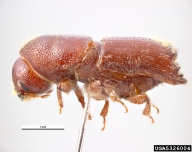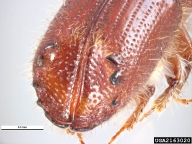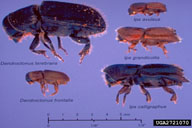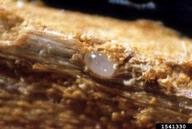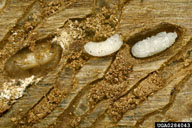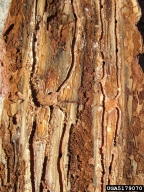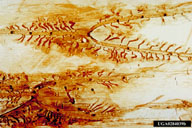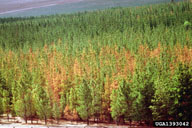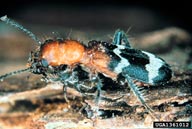Southern pine engraver
Ips grandicollis (Eichhoff) (Coleoptera: Curculionidae, Scolytinae)
Orientation to pest
The southern pine engraver (also called the eastern five-spined Ips), Ips grandicollis (Eichhoff), is a native bark beetle that occurs in the eastern parts of Canada and the United States, in Central America, and on some Caribbean islands. It is also invasive in Australia, where it is a pest of plantations of Monterey pine (Pinus radiata D. Don). The elytra (hardened forewings) end in a scoped out area with typically 5 teeth on each side. It breeds most often in recently felled trees and logging slash, but can also breed in limbs and trunks of live trees that are under attack by other bark beetle species. Most breeding occurs in limbs and the upper crown. Drought and logging both can potentially stimulate outbreaks of this species, causing small infestations to expand in area. The biology of this species is similar to that of Ips pini (Say). Male beetles create a nuptial chamber beneath the bark and produce pheromones that attract multiple females. After mating, the females construct 3 to 5 oviposition galleries that branch off from the nuptial chamber. The parent galleries are kept free of boring dust, unlike those of the southern pine beetle (Dendroctonus frontalis Zimmermann). Larval galleries branch off the oviposition galleries and are usually run horizontally across the tree trunk. Pine engraver beetles can vector a blue stain fungus, which aids the beetle in killing the host tree by clogging the water-transporting elements in the tree. Symptoms and signs of pine engraver attack are essentially the same as those of many bark beetles, including the yellow, red or brown foliage characteristic of dying trees, together with boring dust and pitch tubes on the bark. There are six of more generations per year in the southern United States.
Hosts commonly attacked
Ips grandicollis breeds in most of the pine species in the southern United States. North of the southern pines region, this species is principally found associated with pitch pine (Pinus rigida Mill.).
Distribution
The southern pine engraver is found in eastern Canada and in the eastern United States from Massachusetts west to Minnesota, Nebraska and Texas, and throughout the southern states.
Images of southern pine engraver
| Figure 1. Adult of southern pine engraver, Ips grandicollis. Right, see the scoped out area of the fore wings and the surrounding teeth | ||
| Figure 2. Comparative size of southern pine engraver (Ips grandicollis) relative to other southern pine bark beetles | Figure 3. Egg of southern pine engraver | Figure 4. Callow adult (left), larva (middle), and pupa (right) of southern pine engraver |
| Figure 5. Left, nuptial chambers of southern pine engraver, with five and four oviposition galleries branching off; right, larval galleries branching off oviposition galleries, with pupation cells at end of each gallery | ||
| Figure 6. Group of Monterey pines (P. radiata) in Australia, killed by southern pine engraver | Figure 7. The predatory checkered beetle Thanasimus dubius is a common predator of the southern pine engraver |
Important biological control agents related to this pest species
The natural enemies of the southern pine engraver include the predatory clerid Thanasimus dubius (Fabricius), the predatory trogositid beetle Temnochila virescens (Fabricius), as well as various parasitoids, including Roptrocerus xylophagorum Ratzeburg. Thanasimus dubius and Temnochila virescens have been introduced into Australia against this bark beetle.
Web links for information on southern pine engraver
- Forest Insect & Disease Leaflet 129 | USDA Forest Service
- Quarantined Pest Data Sheet | European & Mediterranean Plant Protection Organization
Articles
- Foltz, J. L., E. P. Merkel, and R. C. Wilkinson. 1984. Annotated bibliography of Dendroctonus terebrans (Oliver), Ips avulsus (Eichhoff), Ips grandicollis (Germar) in the southeastern USA. Monograph #12, Agricultural Experiment Station, University of Florida, 47 pp.
- Lawson, S. A. and F. D. Morgan. 1992. Rearing of two predators, Thanasimus dubius and Temnochila virescens, for the biological control of Ips grandicollis in Australia. Entomologia Experimentalis et Applicata 65: 225-233.
- Abbott, I. 1993. Review of the ecology and control of the introduced bark beetle Ips grandicollis in Western Australia, 1952-1990. CALMScience 1: 35-46.
